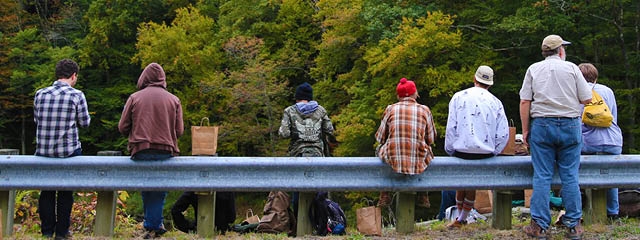The preserved area will protect extraordinary scenic and natural assets for the community as well as serving research and study purposes, said Hampshire College President Jonathan Lash: “Western Massachusetts’ ranges and landscapes are a treasured resource. Hampshire’s partnership with local and state organizations will help conserve these vistas and habitats for future generations.”
Hampshire is applying for Living Building Certification for its R. W. Kern Center, currently under construction on campus. In addition to a net-zero energy, waste, and water building, certification includes a habitat exchange imperative. An equal amount of land, approximately three acres, is required to be preserved in perpetuity.
“In addressing the habitat exchange imperative, we are fortunate to take part in this larger landscape level project, pioneered by Kestrel Land Trust,” said Beth Hooker, Hampshire’s director of food, farm, and sustainability. “Hampshire’s efforts in sustainability reach beyond our campus, and we are delighted to partner with Kestrel Land Trust, the state, and the Town of Hadley to protect this valuable resource.”
Under the agreement, Kestrel Land Trust and the Town of Hadley Conservation Commission will jointly hold the conservation restriction (CR) permanently protecting the property. The Conservation Fund provided Kestrel Land Trust with bridge financing for the project.
The property includes a variety of habitat types, including upland forest, early successional woodland and thicket, open field, forested wetland, wet meadow, pond, and perennial and intermittent streams, including portions of Harts Brook. A six-acre hayfield at the east end is designated for agricultural activities. Together, these habitat resources are recognized for high ecological integrity based on the UMass Conservation Analysis Priorities System and as critical natural landscape in the Massachusetts Natural Heritage & Endangered Species Program.
Kristin DeBoer, executive director of Kestrel Land Trust, described the protection partnership as a sign of the increasing collaboration between area colleges and universities with a commitment to sustainability and conservation organizations in the Pioneer Valley.
“Hampshire College is leading the way to show how educational institutions can protect and care for their land as part of a commitment to environmental sustainability, not only on their core campus but in natural areas that are critical to the entire Pioneer Valley,” said DeBoer. “Kestrel Land Trust was honored to work with Hampshire to achieve this legacy for current and future generations of students as well as for the larger Valley community.”
The Hampshire College conservation project is part of a broader effort—now in its final phases—by Kestrel and Massachusetts Department of Conservation and Recreation to secure protection for an additional 1,000 acres of land on the Mount Holyoke Range, an iconic landmark recognized for local, statewide, and national environmental significance. To support those efforts, DCR and Kestrel received a $1.5 million Landscape Partnership Grant from the Massachusetts Executive Office of Energy and Environmental Affairs in 2014, as well as an anonymous gift of $350,000 and more than $200,000 in additional private contributions and grants. These acquisitions will add to the 10,000 acres already conserved on the Mount Holyoke and Mount Tom Ranges.
Kestrel Land Trust is a regional nonprofit land conservation organization dedicated to conserving the forests, farms, and waterways of the Connecticut River Valley, while nurturing an enduring love of the land.
About the Mount Holyoke Range
The Mount Holyoke Range supports more rare species of plants and animals than any other area in the Massachusetts portion of the Connecticut River valley. This is one of the largest remaining blocks of forest in Massachusetts. Its rare east-west orientation and geologic history of volcanic activity gave rise to numerous rare microhabitats and are home to hundreds of plants and animals: 27 of these are rare or endangered, while other wide-ranging species such as black bear, bobcat, and migratory birds also call the Range home. Rising approximately 1,000 feet from the valley floor, the forested steep slopes support a variety of forest types, including birch-beech-hemlock on the north side and oak-hickory on the south, as well as rock cliffs, streams and ponds that feed the Connecticut River.
The threats to this unique ecology are real. Covering a five-town region, the Range is in danger of becoming isolated from other protected lands, such as the Quabbin Reservoir, and fragmented by housing development, particularly on new side cul-du-sac roads which aim to reach up in elevation for the views. If the majority of the land on these mountain ranges is not fully protected, this dominant landscape feature of the Connecticut River Valley along with its vital economic, biological, educational, geographic, aesthetic, historical and recreational values will be diminished.





